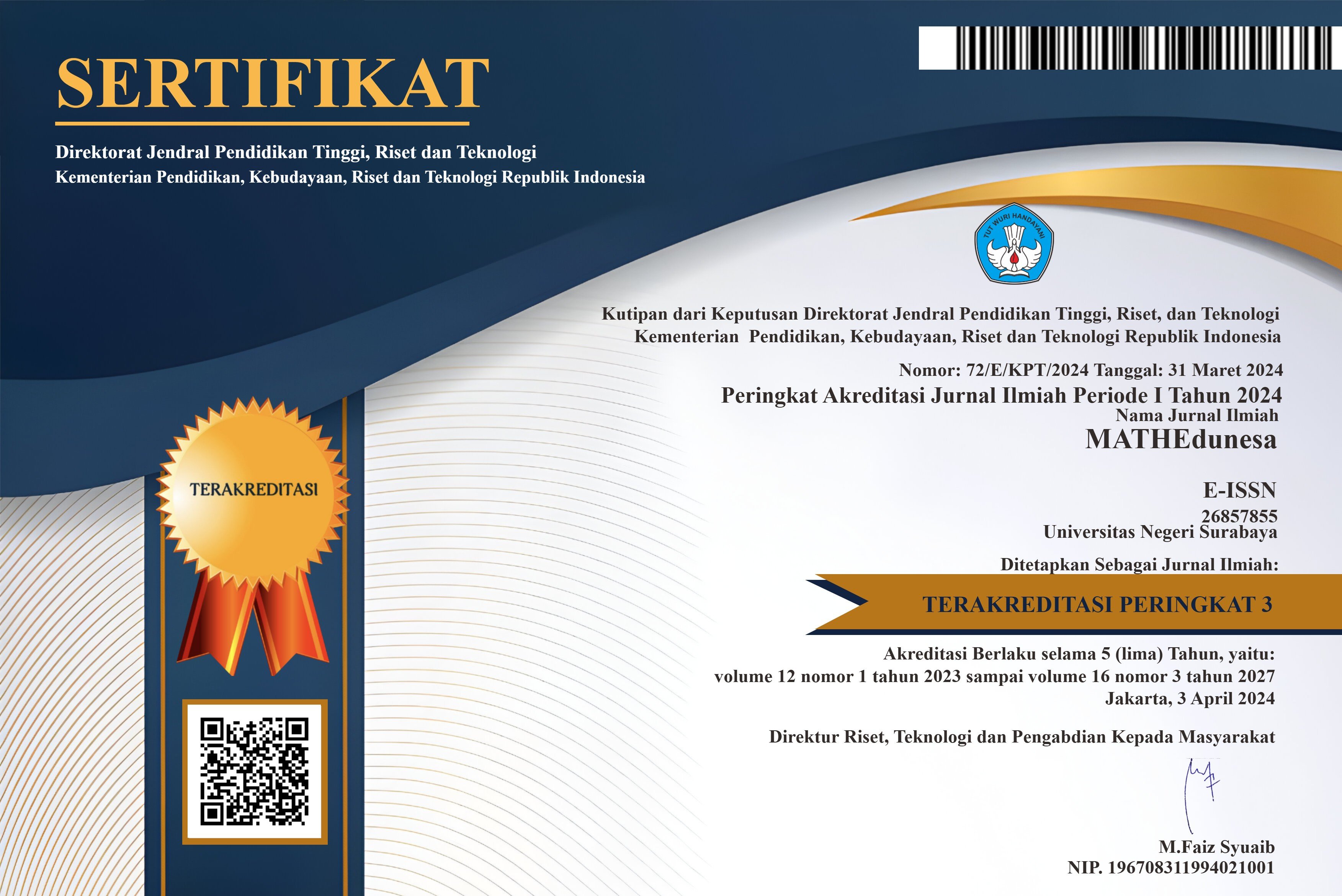LITERASI MATEMATIKA SISWA SMP DALAM MENYELESAIKAN SOAL PROGRAM FOR INTERNATIONAL STUDENT ASSESSMENT (PISA) BERDASARKAN ADVERSITY QUOTIENT (AQ)
DOI:
https://doi.org/10.26740/mathedunesa.v7n3.p638-643Abstract
Kementrian Pendidikan dan Kebudayaan (Kemendikbud) telah mencetuskan Gerakan Literasi Sekolah (GLS) pada tahun 2015, sebagai salah satu upaya untuk meningkatkan mutu pendidikan. Peningkatan literasi ini ditujukkan untuk semua mata pelajaran (Kemendikbud, 2016) di mana matematika menjadi salah satu mata pelajaran wajib (Permendikbud No.21 Tahun 2016). Di dalam literasi matematika, siswa harus mampu merumuskan, menerapkan, dan menafsirkan matematika. Adversity Quotient (AQ) merupakan suatu konsep kerangka kerja baru, tolak ukur, dan alat praktis untuk memahami dan memperbaiki kemampuan seseorang dalam menghadapi kesulitan. Jika dikaitkan dengan literasi matematika, maka AQ dibutuhkan siswa untuk menghadapi kesulitan dalam memecahkan persoalan yang berkaitan dengan literasi matematika. Jenis penelitian ini yaitu deskriptif dengan pendekatan kualitatif. Penelitian ini dilaksanakan pada semester genap tahun ajaran 2017/2018 di SMP kelas VIII. Sumber data diambil dari 3 subjek penelitian, yaitu: 1 siswa camper, 1 siswa peralihan camper-climber, dan 1 siswa climber yang telah dikelompokkan menggunakan Adversity Response Profile (ARP). Peneliti akan mendiskripsikan literasi siswa dalam mengerjakan soal PISA level 2, 3, dan 5, ditinjau dari tipe AQ secara sistematis, menyeluruh, dan obyektif berdasarkan indikator literasi matematika. Siswa camper dapat mememenuhi indikator menyederhanakan suatu situasi atau masalah agar dalam bentuk matematika, mengidentifikasi syarat di balik penentuan bentuk matematika, dan menerapkan fakta dan aturan matematika ketika mencari solusi pada soal PISA level 2 dan 3 serta mememenuhi indikator menyederhanakan suatu situasi atau masalah agar dalam bentuk matematika dan mengidentifikasi syarat di balik penentuan bentuk matematika pada soal PISA level 5. Siswa peralihan camper-climber dapat mememenuhi indikator menyederhanakan suatu situasi atau masalah agar dalam bentuk matematika, mengidentifikasi syarat di balik penentuan bentuk matematika dan menerapkan fakta dan aturan matematika ketika mencari solusi pada soal PISA level 2, 3, dan 5. Siswa peralihan climber dapat mememenuhi indikator menyederhanakan suatu situasi atau masalah agar dalam bentuk matematika, mengidentifikasi syarat di balik penentuan bentuk matematika, menerapkan fakta dan aturan matematika ketika mencari solusi, serta menjelaskan dan membenarkan hasil matematika pada soal PISA level 2, 3, dan 5, serta mememenuhi indikator menjelaskan dan membenarkan hasil matematika pada soal PISA level 5.
Kata Kunci: literasi matematika, Program for International Student Assessment (PISA), Adversity Quotient (AQ).
Kemendikbud has initiated the School Literacy Movement (GLS) in 2015, as one of the efforts to improve the quality of education. This literacy increase is intended for all subjects (Kemendikbud, 2016) where mathematics is one of the compulsory subjects (Permendikbud No.21 of 2016). In mathematics literacy, students must be able to formulate, implement, and interpret mathematics. Adversity Quotient (AQ) is a concept of a new framework, benchmarks, and practical tools to understand and improve ones ability to face difficulties. If it is associated with mathematical literacy, then AQ is needed by students to face difficulties in solving problems related to mathematical literacy. This type of research is descriptive with a qualitative approach. This research was carried out in the even semester of 2017/2018 school year in VIII grade junior high school. Data sources were taken from 3 research subjects, namely: 1 camper student, 1 student camper-climber student, and 1 climber student who had been grouped using the Adversity Response Profile (ARP). Researchers will describe students literacy in working on PISA questions level 2, 3 and 5, in terms of type AQ ??systematically, comprehensively, and objectively based on mathematical literacy indicators. Student campers can fulfill indicators simplifying a situation or problem so that in the form of mathematics, identifying the conditions behind the determination of mathematical forms, and applying facts and rules of mathematics when looking for solutions to level 2 and 3 PISA problems and fulfilling indicators simplifies a situation or problem in order mathematics and identify the conditions behind the determination of mathematical forms in the level 5 PISA problem. Students transition camper-climber can fulfill indicators simplifying a situation or problem so that in the form of mathematics, identify the conditions behind the determination of mathematical forms and apply the facts and rules of mathematics when looking for solutions to PISA questions level 2, 3, and 5. Climber transition students can fulfill indicators simplifying a situation or problem so that in the form of mathematics, identifying the conditions behind the determination of mathematical forms, applying facts and rules of mathematics when looking for solutions, and explain and justify the mathematical results on PISA questions level 2, 3 and 5, and fulfill the indicators explaining and justifying the mathematical results on level 5 PISA problems.
Keywords: mathematics literacy, Program for International Student Assessment (PISA), Adversity Quotient (AQ).
Downloads
Downloads
Published
Issue
Section
 Abstract views: 377
,
Abstract views: 377
, PDF Downloads: 414
PDF Downloads: 414




